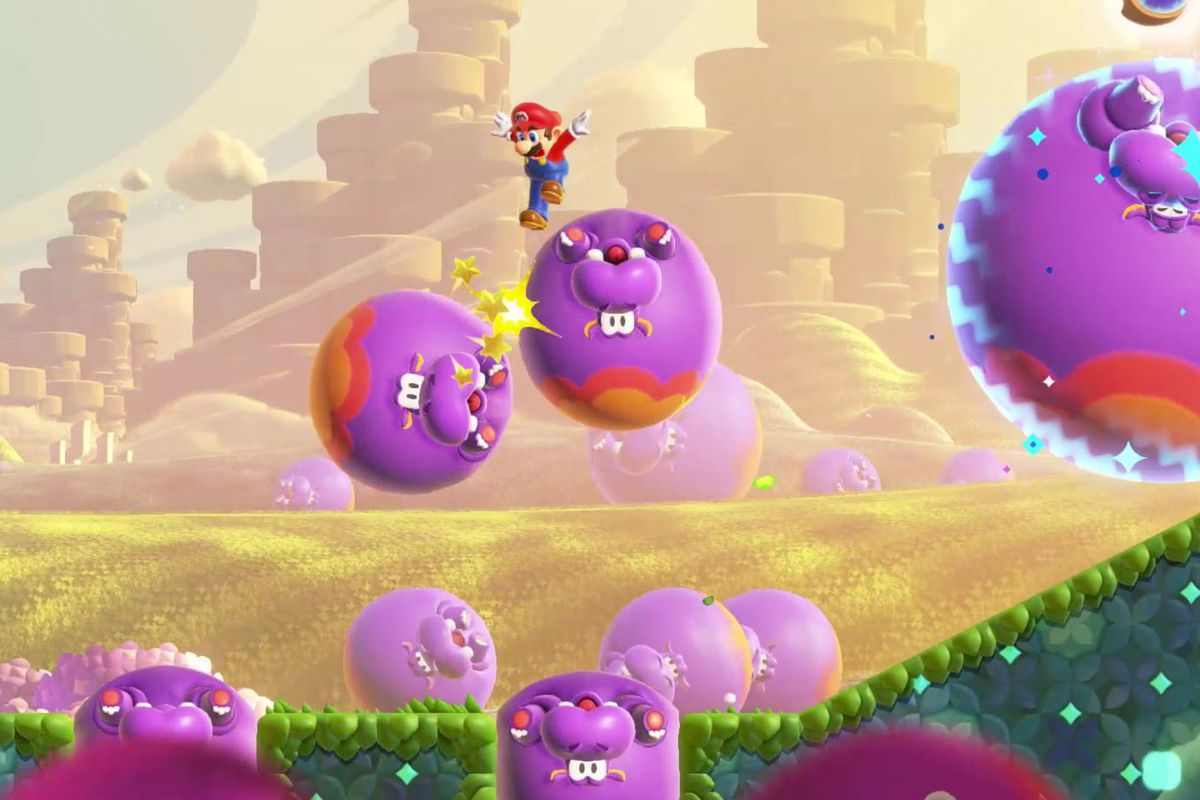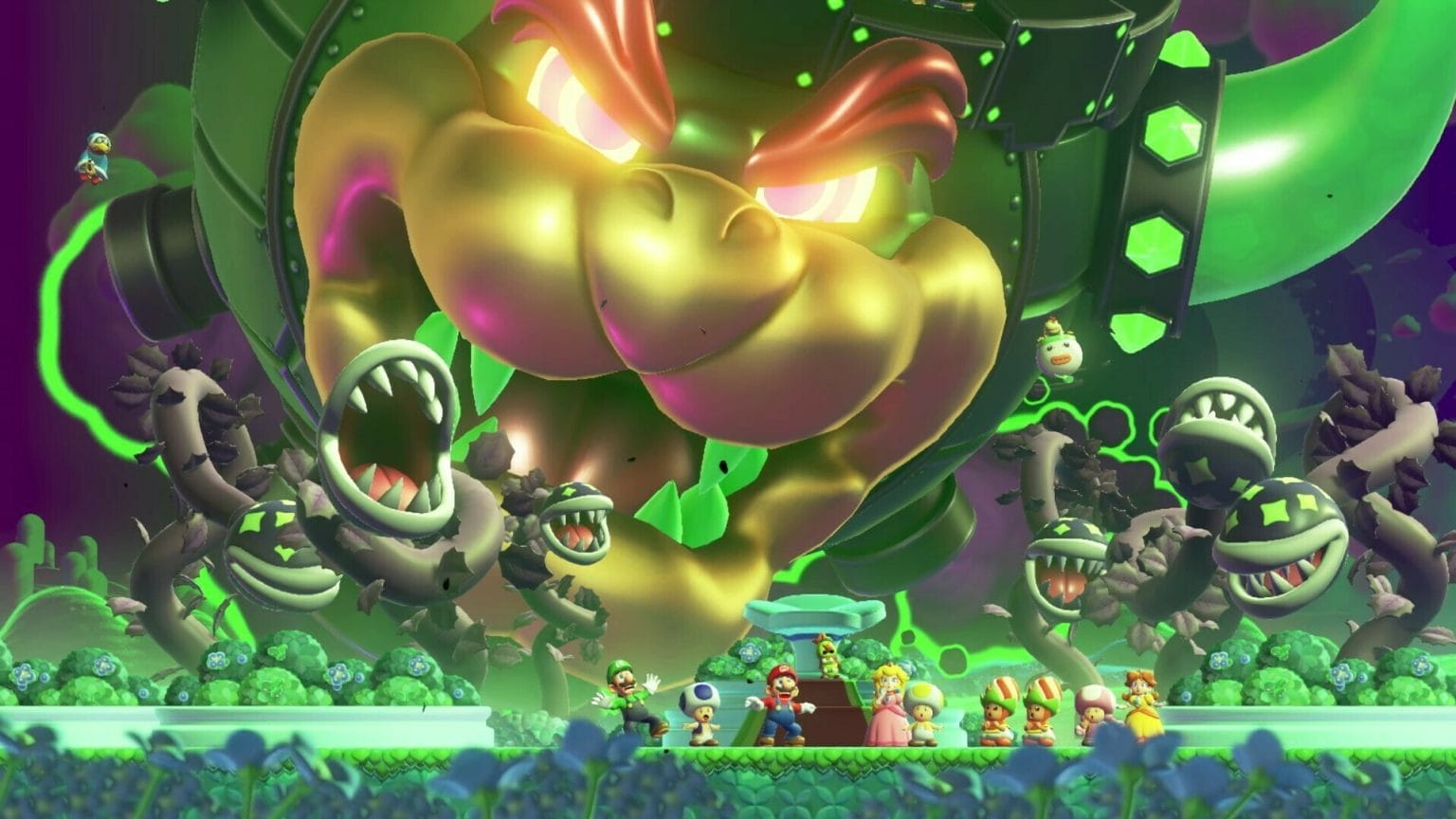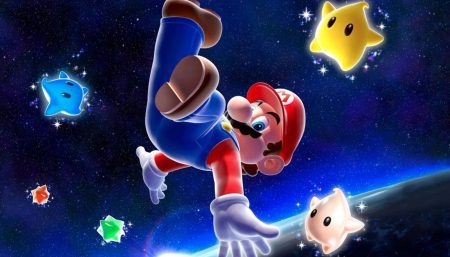The Super Mario Bros. games have always been about wonder. Core to Nintendo’s flagship franchise is the notion that anything could happen at any time, without need for explanation or exposition. Sometimes, you find a feather or a leaf that gives you the ability to fly. Other times, you jump so high you end up finding a secret exit that transports you three worlds ahead. Still, upon close examination, players can easily identify a set of rules governing each Mario Bros. game, and as a result, later entries began to feel predictable and lacking in the element of surprise that attracted players in the first place.
Super Mario Bros. Wonder, the latest 2D Mario title, ratchets up the more fantastical elements to new heights. It’s basically Nintendo’s answer to the question, “What if the randomness was the point?”

What’s Old Is New
At first glance, Wonder appears structurally similar to its forefathers, and in many ways it is. The titular Italian hero (or one of his many pals) completes short, athletic levels in a largely linear manner with the ultimate goal of defeating the villainous Bowser and his evil minions along the way. There are many different macguffins to collect, tons of secret levels and challenges, and easy (but flashy) boss battles. Fun new power-ups shake things up a bit, such as the bubble flower, drill mushroom, and elephant fruit, but those are expected. Even as they greatly enhance the minute-to-minute gameplay experience, the inclusion of new power-ups is par for the course with a Mario game.
Look more deeply, however, and you’ll see the myriad changes found in Super Mario Bros. Wonder are more than just addition, as some of the new systems fundamentally alter how one plays through a Mario game. Most notably, wonder flowers—which appear once in each main level—completely change the rules of play, in some cases turning the player into a completely different creature or object (such as a Goomba or clump of ooze) and in other cases giving you the ability to swim through lava or float like a balloon. Wonder flowers serve as the game’s main hook, and while the stages are a blast to play on their own, the zany antics stemming from the wonder flowers elevate Super Mario Bros. Wonder to a whole new level.
Core to Nintendo’s flagship franchise is the notion that anything could happen at any time, without need for explanation or exposition.
Meanwhile, some of the new mechanics—both bespoke level concepts and recurring ideas—subvert the expectations of even the most experienced Mario player. For example, question blocks don’t just hold coins and power-ups anymore; sometimes hitting one unleashes a wonder flower or causes some small alteration to an interactable object, such as causing a platform to move higher so the player can reach a hidden location. Wonder forces even longtime series veterans to keep an eye out for secrets at every corner, as it’s not as clear as before what actions or objects could even reveal them.
Arguably the biggest gameplay change is the badge system, where players can equip a badge before each level that gives them a special ability for that level. Some examples include the ability to jump extra high, a sensor for finding secrets, the option to start each level with a mushroom, and even complete invisibility. With the badge system, Wonder gives the player a wide array of options to tailor their gameplay experience to their own preferences, and I loved experimenting with each one just to see how different they made everything feel.

In Bloom
I could go on and on about Super Mario Bros. Wonder’s new particularities, but I’d rather emphasize just how much everything feels fresh and new. There are new enemy types, new background themes, newly playable characters (including Daisy!), new online multiplayer options, new level and mini-challenge ideas, and even a new approach to classic airship levels (which I won’t spoil here for those who haven’t played yet).
Every level offers numerous moments that even someone like me—a lifelong Mario fan who’s replayed the classic titles dozens of times—gazed upon in genuine awe. Piranha plants popping out of pipes and breaking into song; playing certain level segments from a top-down perspective; becoming a Goomba and having to stealth my way past simple hazards; and easily finding secret exits because I just so happened to equip the right badge beforehand. So many different things can happen at any given moment, and every time I return to a level for collectibles I missed, I notice new details—hidden coin blocks, cool background animations, and alternate routes.
Despite existing in one of the most recognizable franchises in media, Super Mario Bros. Wonder manages to rarely feel formulaic. Sure, you know that you have to collect coins, grab power-ups, and reach the top of the flag at the end of each stage, but you can never guess what happens in between. In many ways, Wonder is the 2D Mario version of The Legend of Zelda: Breath of the Wild: something familiar in a few fundamental ways, but throws most of the rules out the window in favor of something more magical and creative.

Final Thoughts: Bask in Wonder
While the New Super Mario Bros. titles felt more and more stale with each new release, Wonder offers a litany of never-before-seen Mario ideas that make a concept as simple as 2D platforming constantly surprising and engaging. For a franchise that’s been around for nearly 40 years, Super Mario Bros. still has a number of new tricks up its sleeve, and even after beating every single level, I keep finding new pockets of joy and excitement at every turn.
I don’t know precisely where I’d rank Super Mario Bros. Wonder in comparison to the older titles, but I can say for sure it’s one of the best 2D platformers I’ve played in a long time, and without a doubt a worthy contender for the top five of 2D Mario games. It convinced me there’s still so much more Nintendo can accomplish with its greatest mascot.
Score: 9.6/10

In many ways, Wonder is the 2D Mario version of The Legend of Zelda: Breath of the Wild: something familiar in a few fundamental ways, but throws most of the rules out the window in favor of something more magical and creative.
LIGHTNING ROUND THOUGHTS:
- Even after reaching 100% completion on my initial Wonder save file, I’m still finding myself replaying levels just for the sheer joy of it. Somehow, the fun never ends!
- The main online mode, which involves seeing other players’ Dark Souls-like ghosts in each level, cleverly makes a solo experience feel collaborative in a way. Beyond the mechanical side of things (if you die, you have a few seconds to touch another player-ghost or a “standee” they leave behind to immediately respawn), seeing how other players approach each hazard can reveal new secrets, alternate pathways, and different play styles without getting in your way.
- The new art direction is a marvel. Out are the bland 3D models of New Super Mario Bros., in are more colorful facial expressions and movements, as well as more adorable action animations (e.g. Mario grabbing his hat after entering a pipe sideways or doing a cool pose when grabbing a new power-up). Additionally, each level just bursts with more vivacity, as the level backdrops have more variety to them and teem with broader enemy and hazard variety.
- The music in general is as delightful as always, and I especially love how the music changes based on certain things the player does. For example, the drumbeat of each level disappears when the player stands still, and instruments playing various course melodies change to brass instruments when the player gets the elephant power-up. In Wonder, the music itself is gameplay.
- The actual jump/movement mechanics are brilliant. I’m not sure I can explain the peculiarities of it just yet, but this is as good as a 2D Mario game has felt in 30 years.
- I know some people find the talking flowers annoying, but I found them charming and funny. One of my favorite instances has you going into a secret enclosure and defeating enemies, only for the talking flower to say, “I guess I’m all alone now.” Genuinely hilarious.
Super Mario Bros. Wonder was released on October 20, 2023, for Nintendo Switch. MSRP: $59.99.
Sam has been playing video games since his earliest years and has been writing about them since 2016. He’s a big fan of Nintendo games and complaining about The Last of Us Part II. You either agree wholeheartedly with his opinions or despise them. There is no in between.
A lifelong New Yorker, Sam views gaming as far more than a silly little pastime, and hopes though critical analysis and in-depth reviews to better understand the medium's artistic merit.
Twitter: @sam_martinelli.










